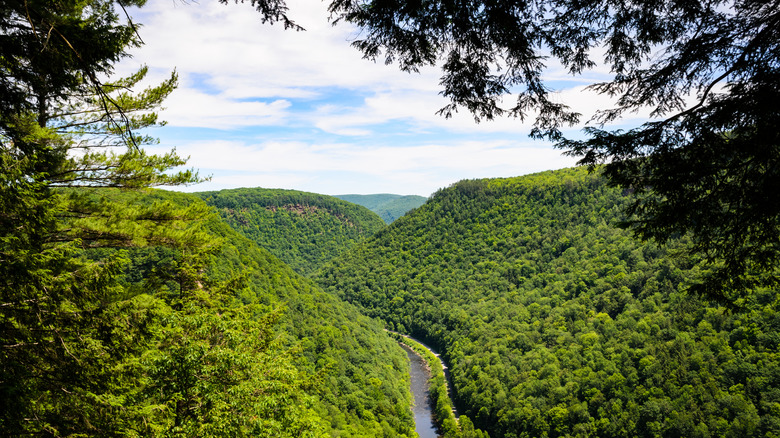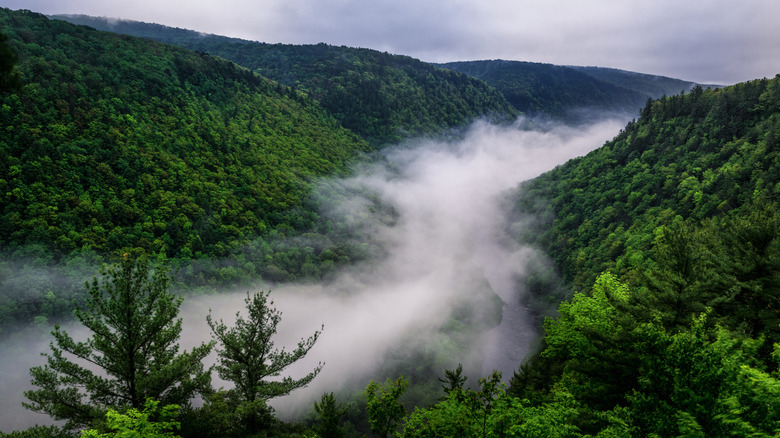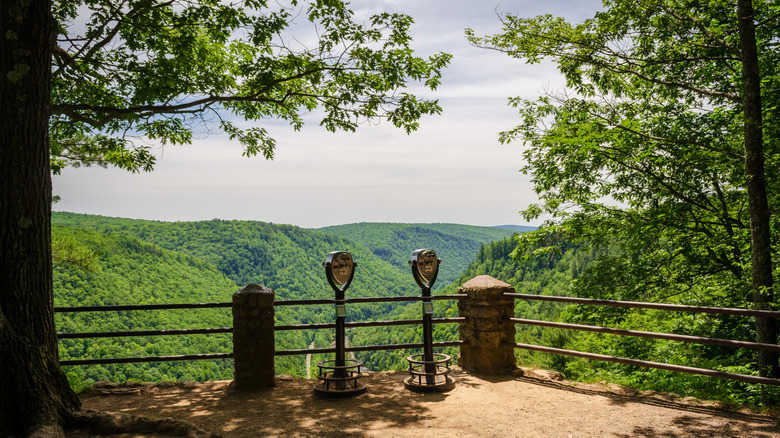An Underrated State Park Is Home To The 'Grand Canyon Of Pennsylvania'
The mighty Grand Canyon is not only the most famous sight in the state of Arizona (by far), but it's also arguably the most globally recognized natural wonder in the entire United States. However, such renown, well deserved as it is, does have some drawbacks. The Grand Canyon is also one of the most visited national parks in the country, with more than 4,700,000 people making the trip in 2023 alone. Large crowds, heavy traffic, and expensive entrance fees often leave travelers looking for alternatives to the grandiose, but over-touristed, Grand Canyon.
The good news is that you don't have to go to Grand Canyon National Park to experience spectacular canyon scenery. In Arizona alone, national monuments like Canyon de Chelly are arguably as iconic and picturesque as the Grand Canyon. But the better news is that you don't even have to travel to the American Southwest to capture some amazing images of deep gorges and epic canyon views. Even east of the Mississippi, many states have their own versions of the "Grand Canyon" that provide the same breathtaking impressions of the iconic Colorado River gorge without the excessive crowds and entrance fees.
One of the best East Coast Grand Canyon alternatives lies in the underrated landscape of Central Pennsylvania, where the Appalachian Mountains meet several gorgeous river valleys and scenic forests. The Pine Creek Gorge, also known as the "Grand Canyon of Pennsylvania," is one of the most impressive sights in the Northeast and home to two of Pennsylvania's most underrated state parks.
Pine Creek Gorge is one of Pennsylvania's top natural wonders
While not quite as large as its famous Arizona counterpart, Pine Creek Gorge does boast perhaps the most dramatic, photogenic views in Pennsylvania. The gorge runs about 47 miles long with a maximum depth of 1,450 feet and a maximum width of around 4,000 feet rim to rim. With such a formidable size and some of Pennsylvania's most picturesque forests, Pine Creek Gorge is undoubtedly one of the most beautiful places in all of America's state and national parks.
Like the Grand Canyon, Pine Creek Gorge formed from the actions of a single waterway over a vast timeframe. In this case, the Pine Creek Gorge was carved by its namesake Pine Creek, a major tributary of the West Branch of Pennsylvania's Susquehanna River. But unlike the Grand Canyon, Pine Creek Gorge also owes its existence to the previous ice ages. Around 20,000 years ago, huge glaciers rolled across what is today Pennsylvania and created a natural dam of silt, mud, and debris. This dam rerouted the course of Pine Creek to the south, where it cut through the Allegheny Plateau and forged the impressive gorge that sits there today.
Pine Creek Gorge is not only an incredible spectacle; it's also one of Pennsylvania's greatest conservation success stories. A century ago, the old-growth forests that once decorated the gorge were so depleted by logging that the then-barren region bore the ignominious nickname "the Pennsylvania Desert." However, the decline of the lumber industry and subsequent conservation efforts have restored the gorge's forests to their former glory. Now, visitors to Pine Creek Gorge experience an epic display of deciduous hardwood forests, with enough evergreen trees to add a constant touch of green all year.
Experience Pine Creek Gorge from both sides in two amazing state parks
Lying along Pine Creek Gorge's east rim is Leonard Harrison State Park, an underrated Pennsylvania destination and a superb way to experience the gorge's beauty firsthand. The park contains beautiful scenic overlooks and immersive nature trails, while also maintaining some convenient infrastructure (including modern restroom facilities, a visitor's center, and a playground). On the opposite end of the gorge is the west rim's Colton Point State Park, an even more underrated destination. Colton Point lacks much of Leonard Harrison's modern infrastructure, but this makes Colton Point the superior destination for enjoying Pine Creek Gorge in its pristine, wild nature.
Both state parks are excellent hiking, camping, mountain biking, fishing, and nature photography destinations. Daring hikers can brave the 62-mile Pine Creek Rail Trail, while day visitors can stick to the much shorter (but equally breathtaking) Turkey Path from the gorge's rim down to Pine Creek itself. Photographers both professional and amateur will find plenty of amazing shots from both parks, especially in autumn when the gorge takes on perhaps the best fall foliage in Pennsylvania.
Pine Creek Gorge is located in the larger Tioga State Forest, which is part of a heavily forested region of North-Central Pennsylvania known as the "Pennsylvania Wilds." If you're lucky enough to visit the Pennsylvania Wilds yourself, you can also go stargazing at Pennsylvania's Cherry Springs State Park, walk over a ruined railroad bridge at Kinzua Bridge State Park, or even see the Northeast's largest remaining free-roaming herd of elk. But as remarkable as these attractions are, few who've visited will disagree that Pine Creek Gorge is the real star of the show.


